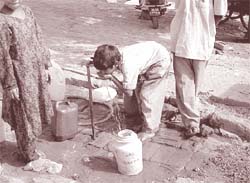Thirsty for breath?
 researchers have linked nitrate in drinking water with recurrent acute respiratory disorder in children. Research conducted by S K Gupta and colleagues at the Satellite Hospital, Bampark, Jaipur has found a relation between high intake of nitrates and symptoms of lung infection ( Environmental Health Perspectives , Vol 108, No 4).
researchers have linked nitrate in drinking water with recurrent acute respiratory disorder in children. Research conducted by S K Gupta and colleagues at the Satellite Hospital, Bampark, Jaipur has found a relation between high intake of nitrates and symptoms of lung infection ( Environmental Health Perspectives , Vol 108, No 4).
The study was conducted on children (aged eight years) from five Rajasthan villages. The children shared a similar socioeconomic condition and diet habits and had a history of respiratory tract infection ( rti ). These villages did not have any industrial units nor were they near highways so as to preclude respiratory infection due to air pollution. The nitrate content in the drinking water in the villages ranged from 26 milligramme (mg) to 459 mg of ions per litre. This, when the World Health Organisation's permissible limit for nitrates in drinking water is only 50 mg ions per litre. The children who had more than six infections per year were considered to have recurrent respiratory tract infections ( rrti ). O n the basis of medical examination taking criterion such as respiratory grunting, chest in drawing and presence of wheezes, they study found that 40-82 per cent of the children had rrti . Blood samples were taken to estimate the methemoglobin (metHb) concentration.
The study shows that nitrate in drinking water increases metHb and free radicals in the blood increases the risk of rri . Bacterial microflora in the mouth and the stomach convert nitrates to nitrites. Nitrites are absorbed in the blood and react with haemoglobin to form metHb. The oxidised haemoglobin has a lower oxygen carrying capacity and causes a lack of oxygen in the lungs along with bringing about constriction of arteries.
Higher intake of nitrates also causes the production of free radicals of nitric oxide and oxygen. Free radicals of nitric oxide also have a high affinity to haemoglobin, the oxygen carrying capacity of blood is further reduced. Free radicals of nitric oxide and oxygen cause dilation of the blood vessels along with damage to the cells. Normal functioning of the lungs depends upon the balance between the dilation and constriction activity but with excess nitrate in water, the process is disturbed and creates condition conducive to infection of the respiratory tract.
Acute respiratory infection is common disease in children and causes around 20 per cent mortality in those younger than five years. A study by the Indian Council of Medical Research in 1990 revealed that 15-30 per cent of childhood deaths occur due to infections of the respiratory tract.
